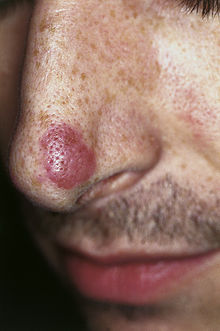- Granuloma faciale
-
Klassifikation nach ICD-10 L92.2 Granuloma faciale [Granuloma eosinophilicum faciei] ICD-10 online (WHO-Version 2011) Das Granuloma faciale, auch Granuloma eosinophilicum faciei oder Eosinophiles Granulom des Gesichts genannt, ist eine chronisch persistierende entzündliche Hauterkrankung mit unbekannter Ursache.[1] Das Granuloma faciale ist durch gut umschiebene einzelne symptomlose erythematöse Flecken oder Knötchen gekennzeichnet, die fast ausschließlich im Gesicht auftreten.[2]
Inhaltsverzeichnis
Beschreibung und Diagnose
Das erstmals 1945 von dem australischen Dermatologen John Edwin Mackonochie Wigley (1892–1962)[3] beschriebene Granuloma faciale[4] ist eine chronische Entzündung der Haut, die für gewöhnlich an der Nase, dem Kinn, der Stirn, der Schläfe oder den Wangen auftritt. Die Erkrankung ist durch eine Erhöhung der Anzahl eosinophiler Granulozyten (Eosinophilie) und eine kutane leukozytoklastische Angiitis (leukozytoklastische Vaskulitis) gekennzeichnet. Sie ist gutartig. Das Granuloma faciale kann in jedem Alter, bevorzugt beim männlichen Geschlecht, auftreten.[1] Es ist in der Regel rund oder oval, mit einer braun-roten Oberfläche die große follikularen Poren aufweist, die an eine Orangenhaut erinnert.[5]
Therapie
Es sind verschiedene Behandlungsmethoden eines Granuloma faciale beschrieben. Beispielsweise medikamentös mittels der lokalen Verabreichung von Tacrolimus[6][7] oder der peroralen Gabe von Dapson[8] (ca. 100 bis 200 mg pro Tag über vier Monate[5]) Auch die intraläsionale Injektion von langwirkenden Glucocorticoiden, wie beispielsweise Triamcinolon, ist eine Behandlungsoption.[5]
Versagen die konservativen Behandlungsmethoden, so kann das Granuloma faciale beispielsweise per Kryochirurgie,[9] Kauterisation[1] oder Laser-Bestrahlung (Argon-Ionen-Laser,[1] Farbstofflaser[10] oder CO2-Laser[11][12]) entfernt werden.[1][5]
Einzelne Granuloma faciale können auch per Exzision behandelt werden.[1]
Prognose
Das Granuloma faciale hat einen chronischen Verlauf und gelegentlich heilt es spontan unter einer narbigen Atrophie.[1]
Weiterführende Literatur
- S. A. Holme, P. Laidler, P. J. Holt: Concurrent granuloma faciale and eosinophilic angiocentric fibrosis. In: The British journal of dermatology Band 153, Nummer 4, Oktober 2005, S. 851–853, ISSN 0007-0963. doi:10.1111/j.1365-2133.2005.06864.x. PMID 16181479. (Review).
- J. Narayan, A. G. Douglas-Jones: Eosinophilic angiocentric fibrosis and granuloma faciale: analysis of cellular infiltrate and review of literature. In: The Annals of otology, rhinology, and laryngology Band 114, Nummer 1 Pt 1, Januar 2005, S. 35–42, ISSN 0003-4894. PMID 15697160. (Review).
- P. E. LeBoit: Granuloma faciale: a diagnosis deserving of dignity. In: The American Journal of dermatopathology Band 24, Nummer 5, Oktober 2002, S. 440–443, ISSN 0193-1091. PMID 12357207. (Review).
- I. Inanir, Y. Alvur: Granuloma faciale with extrafacial lesions. In: The British journal of dermatology Band 145, Nummer 2, August 2001, S. 360–362, ISSN 0007-0963. PMID 11531816. (Review).
- G. Roustan, E. Sánchez Yus, C. Salas, A. Simón: Granuloma faciale with extrafacial lesions. In: Dermatology (Basel, Switzerland) Band 198, Nummer 1, 1999, S. 79–82, ISSN 1018-8665. PMID 10026409. (Review).
Einzelnachweise
- ↑ a b c d e f g P. Altmeyer, M. Bacharach-Buhles: Enzyklopädie der Dermatologie, Venerologie, Allergologie, Umweltmedizin. Springer-Verlag Berlin Heidelberg, 2010, Online-Version
- ↑ J. Thiyanaratnam, S. D. Doherty, B. Krishnan, S. Hsu: Granuloma faciale: Case report and review. In: Dermatology online journal Band 15, Nummer 12, 2009, S. 3, ISSN 1087-2108. PMID 20040253. (Review im Open Access).
- ↑ Orbitury. In: The Britisch medical Journal vom 18. Augiust 1962, S. 485.
- ↑ J. E. Wigley: Eosinophilic Granuloma. ? Sarcoid of Boeck. In: Proceedings of the Royal Society of Medicine Band 38, Nummer 3, Januar 1945, S. 125–126, ISSN 0035-9157. PMID 19992999. PMC 218165.
- ↑ a b c d M. Sand, D. Sand, C. Thrandorf, V. Paech, P. Altmeyer, F. G. Bechara: Cutaneous lesions of the nose. In: Head & face medicine Band 6, 2010, S. 7, ISSN 1746-160X. doi:10.1186/1746-160X-6-7. PMID 20525327. PMC 290354. (Review im Open Access).
- ↑ J. Rieker, U. Hengge, T. Ruzicka, D. Bruch-Gerharz: Multifokales Granuloma eosinophilicum faciei – Erfolgreiche Behandlung mit topischem Tacrolimus. In: Der Hautarzt Band 57, Nummer 4, April 2006, S. 324–326, ISSN 0017-8470. doi:10.1007/s00105-006-1112-0. PMID 16523273.
- ↑ C. Patterson, I. Coutts: Granuloma faciale successfully treated with topical tacrolimus. In: The Australasian journal of dermatology Band 50, Nummer 3, August 2009, S. 217–219, ISSN 1440-0960. doi:10.1111/j.1440-0960.2009.00543.x. PMID 19659988. (Review).
- ↑ P. C. van de Kerkhof: On the efficacy of dapsone in granuloma faciale. In: Acta dermato-venereologica Band 74, Nummer 1, Januar 1994, S. 61–62, ISSN 0001-5555. PMID 7908487.
- ↑ C. Vente, R. Rupprecht, E. Oestmann, S. Menzel, C. Neumann: Granuloma eosinophilicum faciei – erfolgreiche kryochirurgische Behandlung bei sechs Patienten. In: Der Hautarzt Band 49, Nummer 6, S. 477-481, doi:10.1007/s001050050773, PMID 9675575
- ↑ T. Fikrle, K. Pizinger: Granuloma Faciale treated with 595-nm pulsed dye laser. In: Dermatologic surgery Band 37, Nummer 1, Januar 2011, S. 102–104, ISSN 1524-4725. doi:10.1111/j.1524-4725.2010.01823.x. PMID 21070474.
- ↑ W. K. Chung, G. H. Park, C. H. Kim, S. E. Chang, M. W. Lee, J. H. Choi, K. C. Moon, J. K. Koh: Keloidal granuloma faciale after CO2 laser treatment for melanocytic naevus. In: Journal of the European Academy of Dermatology and Venereology : JEADV Band 23, Nummer 5, Mai 2009, S. 611–612, ISSN 1468-3083. PMID 19415815.
- ↑ R. G. Wheeland, J. R. Ashley, D. A. Smith, D. L. Ellis, D. N. Wheeland: Carbon dioxide laser treatment of granuloma faciale. In: The Journal of dermatologic surgery and oncology Band 10, Nummer 9, September 1984, S. 730–733, ISSN 0148-0812. PMID 6434613.
Wikimedia Foundation.

